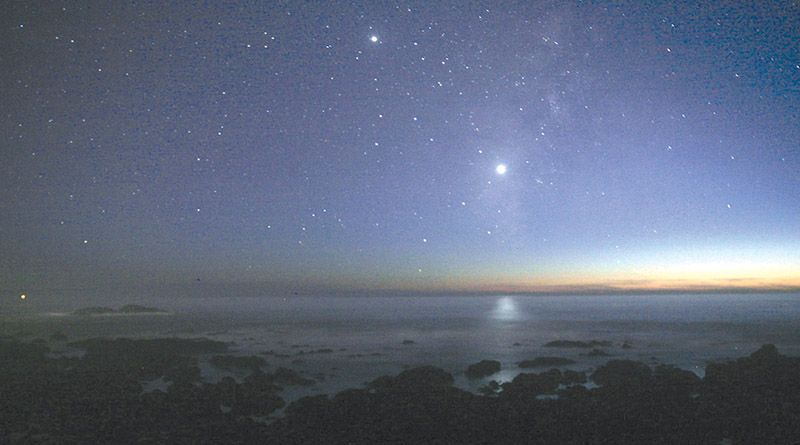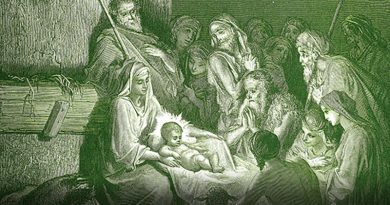Bright Morning Star
By Don Harvey
I, Jesus, have sent my angel to testify unto you these things in the churches. I am the root and offspring of David; and the bright and morning star. (Revelation 22, v. 16)
When the morning stars sang together, and all the Sons of God shouted for joy. (Job 38, v.7)
WHEN I FIRST read the list of the various names attributed to Jesus on which this series of articles would be based, this one immediately caught my attention. Unlike some of them, the reference here to the “star” has a direct connection to the Nativity Season (actually Epiphany more than Christmas itself) and certainly has become a key element in some of the music and liturgical art we associate with the event that changed the world forever. No doubt many of you already have joined in the singing of “Star of wonder, star of light / star with royal beauty bright.” And when we look at a traditional Christmas tree with all of its glittering ornaments, the first thing to get our attention usually is the bright, glittering star at the very top.
Although what we now refer to as “light pollution” in our cities and larger towns diminishes the wonder and glory of the sky on a clear night, from time to time most of us have been in a place where we can observe the great array of stars and planets throughout the night sky in all their splendour. We have found ourselves saying with the psalm writer “The heavens declare the glory of God and the Firmament shows his handiwork.” The display can be breathtaking and even mind boggling, especially when astronomers tell us that there are more stars in the universe than there are grains of sand here on earth!
But despite their glory, because of their magnitude and distance from us, most of these stars (and planets) look identical, especially to the naked eye. However, to those who rise early or stay up late, around 3 am some mornings (when Venus is in the morning sky) one light in the sky drowns out all those around as it shines in all its magnificence. It’s the planet Venus, often known to casual onlookers as The Morning Star.
In the Book of Revelation, St. John the Divine refers to Jesus attributing this quality to himself – “bright and morning star.” We who know and love Him need no convincing that He is just that – outshining all the rest. None can be compared to Him and yet especially during this holy season of Christmas, we are reminded that He knows each one of us personally, and whether we respond or not, He continues to love us and to yearn for our love beyond all measure.
Indeed, the message of Christmas is that the God who created this seemingly limitless universe loved you so passionately that He gave His Son to become one of us and ultimately to die for our sins and shortcomings. He simply wants us to allow “this bright morning star” into our lives that His light may grow and shine through us, and from us flow into the lives of others.
When you look at the Christmas tree and see the star outshining the garish glitter below, do be reminded that He whose birthday we are celebrating is in fact “the lily of the valley – the bright and morning star” who is calling you by your name. It is as real and as personal as that.
When you receive your Christmas Communion this year, recall the penetrating words of Father Frederick Faber’s hymn:
Out beyond the shining
of the furthest star
Thou art ever stretching
Infinitely far.
Yet the hearts of children
Hold what words cannot
And the God of wonders
loves the lowly spot.
Jesu gentlest Saviour
Thou art with us now
Fill us with Thy goodness
Till our hearts o’er flow.
Never doubt that as the King of kings left His heavenly throne to be born into the squalor of a stable in Bethlehem, so through the Blessed Sacrament He enters you, no matter how unworthy you may be. Spreading that Good News by your subsequent words and actions can be your birthday gift to Him in 2021. TAP
The Rt. Rev. Donald F Harvey is Episcopal Vicar for the Anglican Network in Canada and lives with his wife Trudy in St John’s, Newfoundland.
A Great Light
By Ross Hebb
The people who walked in darkness have seen a great light; those who dwelt in a land of deep darkness, on them has light shined. – Isaiah 9:2
CHRIST as Light, Jesus as the Light of the World – this image permeates the pages of Scripture. The image is particularly strong in St John’s Gospel where our Lord states, “I am the light of the world” (9:5). What is its significance? Three functions of light come to mind: light shines into darkness, light reveals the way, and light conquers darkness.
As natural light shines into darkness and reveals what is present, so too Christ shines upon our world and our lives to reveal or unmask the darkness that exists. Our darkness is not physical but spiritual. The darkness Jesus unveils are the unexamined assumptions, the accepted conventions, the conventional wisdom of our age. The accepted lies of our society that the path to happiness lies in and through possessing more things, that all our desires are good, that to gratify them, sooner rather than later, brings both satisfaction and contentment. These are the forces, “the spiritual wickedness in high places” (Ephesians 6:12), which deceive and imprison us. The light of Christ unmasks the lies for what they are. They are, as all good deceptions, partially true. We do need food, shelter and clothing – all necessary worldly things, but they are simply to be used in the pursuit of higher ends. They are not ends in and of themselves and they do not bring happiness. In them “I can’t get no satisfaction” as the great theologians of Rock sang so many decades ago. Satisfaction and happiness lie elsewhere.
Christ as Light also reveals the way. Jesus shows us the fallacy of conventional wisdom, the emptiness of the contemporary. Jesus urges us to higher goals and enduring ones. He teaches that those made in the image and likeness of the Creator need to nourish that image, need to seek to grow into the fullness of their humanity, they need to desire the Good so that they may enjoy the Good which is God. This is done by remembering, by knowing and loving. Recalling, knowing and loving not what is passing, not what we can’t take with us, but the non-material, the spiritual. We need to recall the goodness of Creation, including our own goodness as humans made in the image of the Creator but marred by our confusions and selfishness. We need to know that we are loved and to learn more of that love. Love which is unselfish, which is unconditional and love which, unlike our ‘four-score span of years’ (Psalm 90:10), endures for eternity. To know that love, to learn of that love necessarily entails seeking that love. As Jesus asked his disciples at the beginning of His ministry in John’s Gospel, “What seek ye?” (John 1:37).
Finally, Light conquers darkness. This is not, as is sometimes falsely asserted, a mere hope. The stuff of old movies where the good guys wore white Stetsons. Nor is it simply an assertion that makes for good Disney movies. It is the reality built into creation itself. Try shining darkness into light – so silly the phrase itself is senseless. Yet shine light into darkness and you have visibility, revelation and knowledge! Light conquers darkness! There is obvious darkness in the period in which we now live. Covid 19 has produced isolation, alienation and fear on a scale unknown to present generations. Along with these have come successive waves of societal division. We can almost feel the ‘darkness’ of our times. As with each December, as with every previous Advent, in every prior century, the Church presents us with hope in the midst of an encroaching darkness. Yes, we may live in a land of deep darkness and we will all some day have to pass through the valley of the shadow, but we are not alone. And we are certainly not without Light and hope. The Light which is our God walks with us. The One who walked before us as one of us shines into our darkness and lights for us a Way. The darknesses of our lives and of the forces arraigned against us have not, and will not, defeat Him. As in the manger, so too even now, a Light shines. Perhaps our vision is now cloudy and the Light appears to us as faint, but follow that Light and its brightness will increase, your path will become clearer, the way less faint and your end will become both visible and bright. The One who is the Light of the World shines into our darkness and conquers it saying clearly, “Come to me” (Matthew 11:28). TAP
Canon Dr. Ross Hebb is Rector of St Peter’s Fredericton, NB.
The Sun of Righteousnss
By Rebecca Osborn
“But for you who fear my name, the sun of righteousness shall rise with healing in its wings.” Malachi 4:2
Malachi is the last book in the Old Testament. After the exile, after the return and rebuilding of temple and wall, the nation of Israel was as close to restoration as it was going to get. But that restoration was a disappointment. Specifically, Malachi writes to the post-exilic Jews about God’s disappointment in the worship of Israel. He accuses the priests of corruption and the people of complaining.
In the third chapter, Malachi begins to write about the future, about the Messiah who was yet to come. Most of the images he uses to describe the Messiah make his arrival sound like a reckoning. He will be like fuller’s soap (3:2), an abrasive chemical used with hot water and hard scrubbing to turn loose wool cloth into durable felt. To the Levites and priests, he will be like the refiner’s fire, which burns so hot that it melts away all minerals except gold and silver. Malachi makes a distinction between the righteous and the wicked (3:18). The former will have their names written in a book of life, while the latter will be burned like stubble (4:1), the old stumps that had to be cleared away before any new planting.
Malachi 4:2 begins with a glorious “But!” For those who fear God, whose names are in that book, the coming of the Messiah will be like the rising of “the sun of righteousness.” To excise this one phrase from its context would be to sentimentalize it. It is the one great exception in a litany of punishment.
The sun is the ultimate physical source of life on earth. Without the sun, our planet would be just another rock in space. The sun gives us the beautiful colours of the skies, the changing of the seasons, the warmth trapped in our atmosphere. It is not surprising that many of our pagan ancestors worshiped the sun. But it is an enormous ball of fiery plasma that can burn our eyes even from 148 million kilometers away. In parts of the planet, its heat is so intense that very little can survive. It is only for those who fear the Lord that the coming of the Messiah is a healing comfort.
When the Messiah did come, it would perhaps have surprised Malachi that the healing portion of Jesus’ ministry was at the forefront. Healing was indeed in his wings as he traversed Israel. When John the Baptist inquired of Jesus whether he was the Messiah they were waiting for, Jesus replied with reference to Isaiah 35 and 42: “the blind receive their sight, the lame walk, lepers are cleansed, and the deaf hear, the dead are raised up, the poor have good news preached to them. And blessed is the one who is not offended by me” (Luke 7:22-23).
Many were offended by him, and for them, Jesus’ coming was a judgment. Jesus’ cleansing of the temple (John 2) was a rejection of a corruption that had taken root in the heart of Jewish worship. He accused the Pharisees of interpreting the law of God to make it an impossible burden rather than a force of liberation (Matthew 23:4, Luke 11:46). He offended those who took exception to his eating with tax collectors and allowing the touch of prostitutes. And, of course, the Jewish rulers who eventually had him crucified were jealous of his influence over the Jewish people, and fearful of his destabilizing the system in which they held power under Roman overlords.
But for the most part, Jesus’ judgment was a threat for the future. He told his own parables of judgment which sound similar to Malachi’s metaphors, but added an element of waiting. In the parable of the wheat and the tares (Matthew 13), the servants are instructed to wait for the harvest, when all will be gathered and sorted. In the parable of the final judgment, when the sheep are separated from the goats, the coming of the Son of Man in his glory is still a future event (Matthew 25). We have another chance. The Lord “is patient toward you, not wishing that any should perish, but that all should reach repentance” (2 Peter 3:9b).
The righteousness of God is a refiner’s fire, consuming all that is not holy. Jesus’ judgment of your actions may be a stumbling block. But if you will humble yourself and pray, and fear the Lord over the siren songs of the world, the flesh, and the devil, that judgment will bring healing. Malachi 4:2b says, “You shall go out leaping like calves from the stall.” You might not know it, but that sin that clings so closely is hemming you in. Fear of the Lord will set you free, to find a spiritual youth you didn’t know you had, and to become a force empowered to trample down wickedness (Malachi 4:3).
Healing is comforting. The end is beautiful. But the journey is harrowing and requires great trust. Believe that the Lord loves you and desires your good, and fearing him will not be a burden. It will set you free. TAP
Rebecca Osborn is the Assistant Priest at the Church of the Holy Comforter in Rankin Inlet, Nunavut. Her husband Jared is the Rector, and together they have three daughters.




